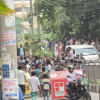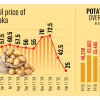Field test on for 3 more GM crops
Inspired by the success of the country's first commercially released biotech crop -- Bt brinjal -- in 2013, Bangladesh is now field testing three more crops developed through applications of agro-biotechnology.
These are: late blight resistant potato, Bt cotton and vitamin-A enriched Golden Rice.
The International Service for the Acquisition of Agri-biotech Applications (ISAAA), a non-profit international organisation that keeps watch on production and expansion of biotech crops worldwide, said this in its latest report titled “Global Status of Commercialised Biotech/GM Crops:2015.”
Sources at the agriculture ministry and different agro-research institutions confirmed The Daily Star that the new ISAAA report, prepared marking the 20th anniversary of the commercialisation of biotech crops, would be launched at a programme in Dhaka today.
Earlier, the ISAAA had a global launch of this report in Beijing on April 13, showcasing the global increase in biotech acreage from 1.7 million hectares in 1996 to 179.7 million hectares in 2015. This 100-fold increase in just 20 years makes biotechnology the fastest adopted crop technology in recent times, reflecting farmer satisfaction with biotech crops, it said.
The ISAAA, governed by an international board of directors, is composed of three centres: the AfriCenter in Nairobi, Kenya; AmeriCenter, Ithaca, New York; and the SEAsiaCenter in Los Baños, the Philippines.
The ISAAA report said, “Success with Bt brinjal has led Bangladesh to prioritise the field testing of a new late blight resistant potato [an important crop occupying 0.5 million hectares in Bangladesh] which could be approved as early as 2017.”
Potato is the fourth most important food staple globally and with an annual output of nine million tonnes, Bangladesh is now a potato exporting country.
Once released, the RB (blight resistant) potato will be farmers' answer to late blight, one of the most devastating plant diseases caused by fungal attack, Rafiqul Islam Mondal, director general of Bangladesh Agricultural Research Institute (BARI), told The Daily Star. He is optimistic that the biotech potato will get regulatory approval by 2017.
Farmers in Bangladesh spend up to Tk 100 crore a year in spraying 500 tonnes of fungicide to protect this major tuber crop.
“Given the importance of the large cotton/textile industry in Bangladesh, Bt cotton is being evaluated in field trials as well as Golden Rice, which could address the prevalent Vitamin A deficiency in the country,” stated the ISAAA report.
The Bt cotton seeds are infused with genetic traits taken from a soil-dwelling bacterium -- Bacillus thuringiensis (Bt) -- that effectively fights bollworm, a harmful caterpillar responsible for damaging cotton yields.
Each year Bangladesh grows a paltry 0.15 million bales of cotton and spends up to Tk 20,000 crore for importing over 5 million bales more to meet the demand, said Cotton Development Board (CDB) Executive Director Farid Uddin.
Industry sources said typical synthetic pesticides have become increasingly ineffective in fighting cotton bollworm, thereby causing up to 20 percent crop losses. Cotton growers' expenditure on pesticides accounts for 40 percent of the total production costs.
“China is just one example of biotechnology's benefits for farmers in developing countries. Between 1997 and 2014, biotech cotton varieties brought an estimated $17.5 billion worth of benefits to Chinese cotton farmers, and they realised $1.3 billion in 2014 alone,” explained ISAAA Global Coordinator Randy Hautea.
Also in 2015, India became the leading cotton producer in the world with much of its growth attributed to biotech Bt cotton. India is the largest biotech cotton country in the world with 11.6 million hectares planted in 2015 by 7.7 million small farmers. In 2014 and 2015, an impressive 95 percent of India's cotton crop was planted with biotech seed; China's adoption in 2015 was 96 percent.
Meanwhile, scientists at the Bangladesh Rice Research Institute (BRRI) told The Daily Star that on completion of a successful trial of the genetically engineered Golden Rice at the transgenic screen house of BRRI, they have taken the biotech rice -- GR-2 E BRRI dhan29 -- to confined field trials late last year.
As follow-up steps, open-field and multi-location trials would be conducted, setting into motion the last stage for its release to the farmers, they added.
Along with two other rice varieties (IR-64, a variety developed by the International Rice Research Institute, and RC-28, a Filipino variety), BRRI Dhan-29, one of Bangladesh's most productive rice varieties, has been genetically engineered to have greater expressions of a corn gene responsible for producing beta carotene (also known as pro-vitamin A). This has been widely publicised as Golden Rice for its yellowish colour.
Rice does not contain any beta carotene. Dependence on rice as the predominant food source, therefore, necessarily leads to Vitamin A deficiency (VAD), most severely affecting small children and pregnant women.
Consumption of only 150 gram of Golden Rice a day is expected to supply half of the recommended daily intake (RDA) of vitamin A for an adult. People in Bangladesh depend on rice for 70 percent of their daily calorie intakes.
According to World Health Organisation (WHO) global database on vitamin A deficiency, one in every five pre-school children in Bangladesh is vitamin A-deficient. Among pregnant women, 23.7 percent suffer from the deficiency.
The IRRI says VAD is the main cause of preventable blindness in children and globally, some 6.7 million children die every year and another 3,50,000 go blind because they are vitamin A-deficient.
Referring to doubling of Bt brinjal acreage from 12 hectares in 2014 to 25 hectares in 2015, the ISAAA credited the success to Bangladesh's political will, particularly from Agriculture Minister Matia Chowdhury.
It said, “Importantly, seed [Bt brinjal] is now being multiplied to meet the growing needs of substantially more farmers in 2016.”
“Since 1996, 2 billon hectares of arable land -- a massive area more than twice the landmass of China or the United States -- have been planted with biotech crops. Additionally, it is estimated that farmers in up to 28 countries have reaped more than US$150 billion in benefits from biotech crops since 1996. This has helped alleviate poverty for up to 16.5 million small farmers and their families annually totalling about 65 million people, who are some of the poorest people in the world,” said the ISAAA report.

 For all latest news, follow The Daily Star's Google News channel.
For all latest news, follow The Daily Star's Google News channel. 








Comments